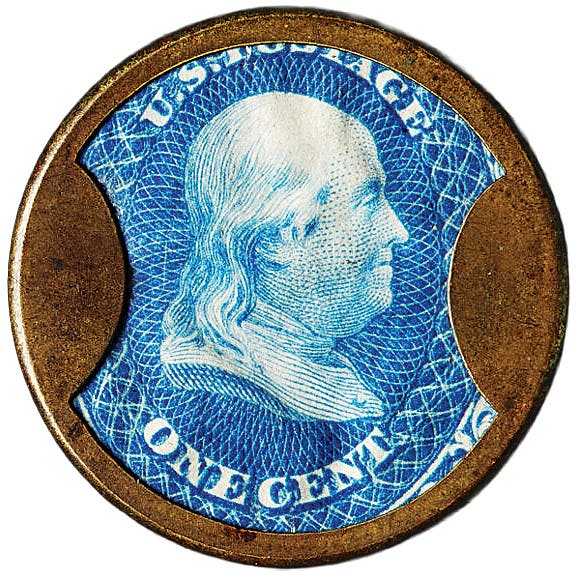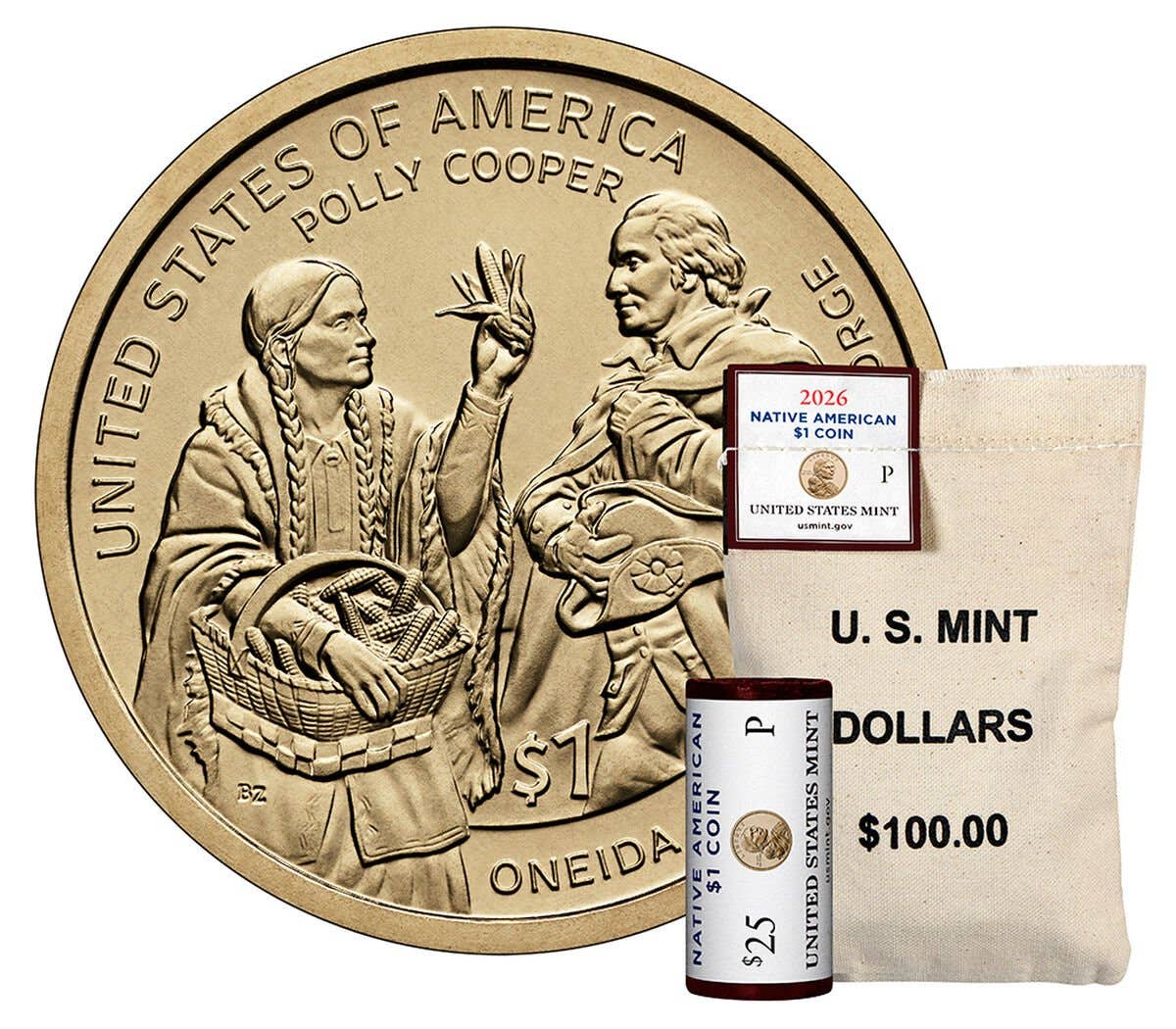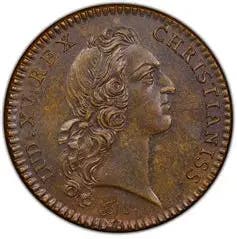This week’s letters (11/15/11)
A selection of letters from readers of Numismatic News to editor, Dave Harper.
Board member puts in vote for Team ANA colors
May I add my two and a half cents’ worth, for and on the record, to your Class of ’63 column/editorial “Root, root, root...” as to American Numismatic Association Board team colors: black and blue spotted uniforms would fit or just do fine.
Thanks for your positive and thoughtful editorial comments with regard to the ANA Board. They really made me know my humble efforts as a board member are appreciated. I even smiled.
On another matter worth “musing about as well” came to my attention while I was having a conversation with two Pennsylvania Association of Numismatists members, who in good cheer offered the following: “Walter, do you really know the reason why last year’s ANA election barely had enough nominated candidates for the nine elected offices?” “Well, no, tell me!” “Simple, nearly everyone realizes it’s a real hard-working job now, rather than a ceremonial cake walk!”
Walt Ostromecki
ANA Vice President
Panorama City, Calif.
Why was Larry Shepherd terminated from ANA?
It seems pretty shocking to see Larry Shepherd let go as executive director of the American Numismatic Association. Particularly, since a few years ago he probably saved the ANA from financial disaster.
Having known Larry from his days as a dealer (Simco) out of the Cincinnati area, it’s difficult to understand why this step was taken by the Board of Governors. He seemed to be doing a good job. Where can you find someone with his financial background plus his keen expertise and knowledge of the coin business to run this organization?
I only hope Larry was compensated adequately for the job he did for the ANA members.
Name withheld
Fort Plain, N.Y.
Harper’s Oct. 25 column about ANA right on target
The Oct. 25 column, “Root, root, root for the home team,” was right on the mark. We’re all curious about what the heck happened, but we should rest assured the ANA will go on as the most outstanding and beneficial organization in U.S. numismatics. Through its history, the ANA has had its share of hiccups, but it always rights itself under the organizational framework. To paraphrase Cliff Mishler at the end of the Cipoletti adventure, “Even with its warts, the ANA will always be a great numismatic organization.”
Jeff Reichenberger
Wisconsin
1883 ‘V’ nickel circulated its way to 2011 change jar
I was visiting my stepdaughter and her boyfriend at their apartment when I saw a large jug of change. I asked to look through it, and after pouring some out on the table, I spied a “V” nickel. I was surprised to see any “V” nickel, but became dumbstruck when I saw that it was the 1883 with “CENTS” variety in Good.
I asked him where he got it and he said he wasn’t sure, just picked it up in change somewhere. Hard for me to fathom somebody deciding to just spend this coin as 5 cents. I also wonder how many hands it passed through after being spent before it was spied by a coin collector like myself.
Keep looking, there are still collectible coins out there.
Matthew May
Auburn, Maine
Workers find group of coins in unlikely place
I would like to share a story with your readers about something that happened in the summer of 1986. I and five other guys were re-roofing a school. Another guy and I were working near the edge of the roof and the rest of the crew was on another section.
All of a sudden, the guy with me said, “Look what I found!” It was a Mercury dime. Now, none of us were collectors back then, but we knew what a silver coin was. So we both started looking around and we found another dime.
Soon we were on our hands and knees looking for more coins. We were looking for a few minutes when the rest of the crew asked us what we were doing. We told them and all six of us were crawling around on the stone roof looking for coins.
After we finished finding the coins, we went back to work. We had all agreed that at the end of the workday, we would count and divide the coins up. If my memory serves me right, we found about 30 Standing Liberty and Washington quarters, 40 Mercury and Roosevelt dimes and maybe 30 war nickels.
They must have been up on the roof for some time because we had to chip a lot of them out of the tar and move stones to find them. I do not know what the price of silver was at that time, but we all thought we were millionaires after finding that treasure.
Dean Buchinger
Reese, Mich.
Bag search yields five Walking Liberty halves
I’ve been searching rolls of coins for about a year now and have found it to be a very rewarding and enjoyable experience. Most of the time I search through rolls of cents. The oldest wheat cent I’ve found was a no-mintmark cent from 1910. Not valuable, but very exciting. It seems that out of every 2,500 cents, six are wheat cents.
Last week I decided to get a bag of half dollars from the local credit union. I was rewarded with five 40 percent silver Kennedy halves, six Franklin halves and (still in shock) five Walking Liberty halves! That made my week.
Happy roll hunting.
R.C. Klinkel
Lake Preston, S.D.
Unfamiliar characteristic shows up on half dollars
I purchased a number of proofs in Boise, Idaho. I found different types of errors. But there is one type of error that I could not find in any of my books. Maybe you could help me.
What I have is a 1987 Kennedy half dollar that does not have “F.G.” but “F.C.”
Then I have two 1986 dates and one 1987 date that have an incomplete “F.G.” and “G,” more like a “C.”
I am enclosing a photo of the “F.C.”
I thank you for any help you can give. Maybe this one is for Mr. Potter.
Frank Hennings
Cascade, Idaho
Editor’s note: Thanks for the report. Errors on proofs are indeed much more unusual than the same errors on circulation strikes, but in this case the missing portion of the “G” is so minute it is little more than a curiosity. Keep on checking those proofs.
Several ATB quarters spotted in Minneapolis
Here in Minneapolis, Minn., I have actually received several America The Beautiful Quarters, but I don’t need them since I have a subscription with the U.S. Mint for proof and BU sets, several actually. So, I’m all set with those.
Strangely, I have received in change several silver quarters and a few wheat cents lately and also what appear to be uncirculated older Lincoln Memorial cents too.
I have a theory that nobody ever spends their pennies. They put them in a jar, drawer, wherever, and they just keep accumulating. Then for some reason, they take them to the bank and cash them in all at once. The bank deals them out to whoever and they begin to circulate, so I could be getting some of that change at the local convenience store.
Just today, I got a 1960-D Lincoln Memorial cent in brand new uncirculated condition, so I looked through all of my albums and folders hoping I’d need one or could upgrade one, but none were less than Mint State, so I just put it into a 2x2 and stored it away.
Two days ago, I got a 1946 quarter and two common wheat cents at the same time. Too bad I didn’t notice that until I got home hours later. I would have bugged the cashier to check all her change for me.
In these economic times, people are spending their change from their change buckets, jars, drawers, etc., and we the collectors have a new opportunity to snag a few of them.
Dennis Post
Minneapolis, Minn.
ANA’s silence worsens issue, hurts itself
I don’t know anything about the Larry Shepherd story except what’s been said in the mainstream numismatic press, which isn’t much. I’ve never met him, but I do know that when hired by the American Numismatic Association, he had a reputation as a real professional and stand-up guy, which was why they hired him.
They haven’t said why he was fired. But it didn’t keep a leading numismatic firm from immediately hiring Shepherd. One doubts this would have happened had Shepherd been tarnished by some grave offense.
You might think that with all the disastrous messes the ANA has been through in recent memory, they would do everything possible to avoid repeating that sorry pattern; and, whatever may have been the concerns regarding Shepherd, the ANA would have striven mightily to work them out in a low-key manner without creating another ugly public blow-up. But no, they just fired him, without explaining why. As if trying to keep a lid on it might just work.
Now, yet again, the ANA is back to conducting a search for a new executive director. Good luck. I don’t know why anyone with sufficient qualifications, in his or her right mind, would want to accept this poisoned chalice.
Frank S. Robinson
Albany, N.Y.
Issuing $200 bill ignores inflation pattern
The year 1964 was the last hurrah for circulating 90 percent silver coin issues. The 1950s and early 1960s were great days for collectors. Uncirculated hundred year old silver dollars could be bought for $2 or less. Even the banks were friendly and helpful to collectors. Back then, $100 had the buying power that now requires $730.79 according to the U.S. Bureau of Labor Statistics.
Just for fun, or perhaps horror of it, go to: www.bls.gov/data/inflation_calculator.htm and try any year of your choice going back to 1913 and the start of the Federal Reserve’s watch over the incredible shrinking dollar. Their numbers are not quite science fiction but they perhaps understate the true effect on consumer prices.
Without the compensation of advances in technology, labor-saving devices and a few cost of living raises along the way, most people might conclude that the U.S. had been in a 98-year economic death spiral to the dark ages.
Going back to 1913, we see $100 was equivalent to $2,288.33 in 2011. So should they issue a $700 or a $2,200 note? Issuing a $200 bill is just another joke that ignores reality.
Practically speaking, the government should eliminate the 1, 5- and 10-cent pieces and issue $500 and $1,000 bills. But don’t expect anyone to wake them from their imaginary dream world of denial. Many persons in government may look forward to the day of a totally cashless society and 100 percent Uncle Sam Electronic (USE) money, so that they could mandate the next step in social engineering and control of people: making all transactions reportable to the Big Uncle. Oh well, a $200 bill, what’s the USE?
Gerald Perman
California
ANA secrecy toughens job for local clubs
Dear ANA Club & District Representatives,
Attached you will find the first “What’s going on at the ANA” newsletter. I hope you will find this monthly letter beneficial.
Oded Paz
National Coordinator
ANA District Representatives Program
Mr. Paz:
Unfortunately, many American Numismatic Association members really do want to know “what’s going on at the ANA,” as you put it.
In other words, they want to know the real reasons for the termination of Larry Shepherd’s contract. They want to know if Mr. Shepherd was given due process and allowed to give his side of the matter. They want to know why ANA has a very poor track record when it comes to hiring and keeping CEOs.
As an ANA member, I believe that I am entitled to these answers. As a club rep, I believe that I need these answers to give intelligent responses to club members’ questions. Any suggestions? Thanks.
Ray Lockwood
Education Director
Central States Numismatic Society
Marion, Ind.
Oct. 4 NN article correction
We have just one minor correction regarding the story we did on the Harry W. Bass Jr. Collection Part V by Stack’s Bowers at the 2011 World’s Fair of Money in Chicago (Oct. 4, “Bass sheets at $1.3 million”).
Our story mentioned that only one of the 55 lots didn’t sell in this magnificent sale. After viewing the press release for the sale, we found that all 55 lots did sell, which is unusual for any sale.
John and Nancy Wilson
Ocala, Fla.
Hollis book makes for good, informative read
If you ever attended college, you are aware of what is considered required reading. Well, if you are going to collect coins or currency, it should be required to read American Numismatist by Paul Hollis. I started reading the Foreword by John Albanese and got so excited, I could not stop reading. I read the first seven chapters, before I looked at the clock and it was 2 a.m.
If you like coinage or history, then get yourself a copy of American Numismatist. It will be the best thing you’ve read in some time, except perhaps Numismatic News. Albanese graded the book a Mint State 70.
Michael P. Schmeyer
Spencer, N.Y.
ATBs in Shawnee, Kan.
I have obtained most of the America The Beautiful coins from, of all places, our Wonder Bakery outlet here in my city. The lady says they get their coins from the bank just a block from their location. My regular bank brings in the Presidential dollar coins, but they do not get the ATB quarters. The ladies at the store do try to save the ATB quarters for me and a couple of times, I’ve given them an Ike dollar as a token of my appreciation.
At my regular bank, the tellers are good about keeping rolls of the newly released dollar coins available for me. I asked the branch manager to accept a couple of boxes of chocolates for my appreciation. A gesture, regardless how small will be remembered along with those “Thank You’s.”
Of course, the only other place to get the ATB coins is at the local pawn/coin shops, but expect to pay a premium.
Ken Kassen
Shawnee, Kan.
Grading both sides of a coin not a new practice
In an Oct. 4 Letter to the Editor, a reader made the logical suggestion that each side of a coin be graded separately. I agree. The system he suggested was in use about forty years ago as two-sided grading was incorporated into the grading system Charles Hoskins and I formulated to identify coins sent to the American Numismatic Association’s Authentication Service in Washington, D.C.
That system was developed further to become the Technical Grading System we used at the first third-party grading service at the International Numismatic Society’s Authentication Bureau (INSAB). Initially, our grading was offered at no additional charge and predated the ANA’s grading service by almost two years.
Technical grading sought to identify a coin’s state of preservation and the best way to do that was to describe both sides. Let me offer an extreme example to make my point.
Which coin can you visualize best in this example: An 1881-S Morgan Dollar graded MS-64; or one graded MS-64, weak strike (obverse) / MS-65 prooflike (reverse)?
According to the ANA Grading Guide, a typical MS-64 coin has some light marks (none very detracting), no wear, and pleasing luster. A prooflike surface on the reverse has no bearing on the commercial MS-64 grade and its “gem” reverse would not either. An MS-64 coin may also be a coin with great luster, no wear, virtually no contact marks - a real gem; yet have a weak strike. Finally, there are many cases where an MS-65/MS-63 coin is given a grade of MS-64. With so many variables, what does a sight-unseen MS-64 coin look like?
In the future, as the value of our coins goes up or with a new 0-100 grading system, we may be destined to repeat the past and grade both sides of a coin again.
F. Michael Fazzari
Tampa, FL
Collector had best year in 60 years of searching
I am one of those old people – late 70s – with a small pension, so I scrap out metal and old PCs. It helps pay for my hobby of coins and this year has been a good one for me. I am still finding some wheat cents and many different errors in Lincoln cents.
Jefferson has been very good to me. How about from 1939 and up? My best friends that Mr. Jefferson has given are 12 2009-Ds plus 10 rolls of 2010-D. Now the 2010-Ds gave me some nice errors, die break on dome (20 of them) plus die break on dome and die chip on the “F” in “FIVE” – 41 of them.
There is more. First window at 3 o’clock. Inside the window there are two spikes, one upper and one lower. It could be a doubled die. I have 96 of them. But this is not the end. Obverse doubling – LIBERTY – 76 of them. Reverse doubling – Monticello (“LLO”) and CENTS (“TS”), probably ejection double. But so many alike.
Dimes – one blank and one flip.
Kennedy halves – I found on reverse no Fs to NO F.G. A weak strike 197?, just like the one in Strike it Rich with Pocket Change, on page 242.
Ike dollars – different dates, peg legs.
Now for proofs. RPMS, wire marks, incuses, no FG but E.C., broad strike, die cracks – Jefferson obverse three-point stars, die breaks, double rims.
I will say this is my best-ever find in more than 60 years. There is a lot more that I did not write about. It is time for my nap, so keep looking out there.
Frank Hennings
Cascade, Idaho
Vicksburg nice addition to parks quarter program
Just a couple lines to let you hear from me again. I want to report that I have found more of the new Vicksburg, Miss., quarters. I think they are pretty neat. Most of the national park quarters are nice.
Virgil Griffith Jr.
Camden, N.C.
Reader overlooks numismatic value in theft
In a letter to the editor in the Oct. 25 Numismatic News, Rick Notkin complains that when figuring the amount stolen from the Mint by William Gray one should use face value to determine the “size” of the theft rather than numismatic value. This can be easily shown to be totally ridiculous by considering what crime you would consider charging someone who stole one of the 5 known 1913 Liberty Head Nickels? If, as Mr Notkin would suggest, you charge them with stealing a nickel, then it would be a petty crime that wouldn’t even make it into the courts – but I’m pretty sure the owner would consider the theft a considerably bigger issue.
Jeff Proehl
Cornish, N.H.
First fall ANA show was successful
The first Fall American Numismatic Association National Money Show (NMS) in Pittsburgh, Pa., on Oct. 13-15, was successful, though we think attendance could have been better. Attendance for the Scout Clinic on Saturday was huge and overfilled the testing area. After the clinic ended, well over 250 scouts and their families invaded the bourse floor. The Kids Zone had long lines almost up to the end of the convention. We sincerely want to thank General Chairman Sam Deep, his committee, and the Pennsylvania Association of Numismatists (PAN) for hosting the event. Thanks also to President Ken Hallenbeck and the Board for their work and dedication to the ANA.
A convention of this magnitude wouldn’t be possible without the hard working ANA staff and in particular, the Convention Department and its Director Rhonda Scurek. Thanks also to the local committee, the ANA National Volunteers, exhibitors, Museum Showcase (and special exhibits), judges, speakers, sponsors, Heritage Auctions (HA.com), Krause Publications, the numismatic press, great security, coin club tables and dealers who had tables at the convention. Without the dealers and sponsors, we wouldn’t have ANA Conventions or the well done Official Program. A well-deserved kudos to everyone who worked hard and contributed to the success of this convention. We look forward to the next NMS in Denver, Colo., on May 10-12, 2012.
Yours in numismatics,
John and Nancy Wilson
ANA National Volunteers
Ocala, Fla.
Remember ANA’s mission when judging budget, expenses
When we look at the American Numismatic Association budget and the various coin conventions that they sponsor we should not overlook the mission of the ANA which is stated on their website, www.money.org:
“The American Numismatic Association is a nonprofit educational organization dedicated to educating and encouraging people to study and collect money and related items. With nearly 33,000 members, the Association serves the academic community, collectors and the general public with an interest in numismatics. The ANA helps all people discover and explore the world of money through its vast array of programs including its education and outreach, museum, library, publications, conventions and seminars.”
The bottom line is do the expenses in the budget support this mission statement? Assuming the answer is yes and the ANA wants not only a balanced budget at the beginning of the fiscal year but an actual profit at the end of the year, then management needs to find the income source(s) to pay the bills. This income source could be from bourse and auction fees, convention admission fees, membership dues, advertising fees, donations, interested on investments, etc. This budget process in not an easy undertaking by the ANA staff nor taken lightly by the ANA board. Difficult decisions need to be made and are made by ANA Senior Staff and the Board of Governors in support of the ANA long term strategic plan.
Gary Lewis
Cape Coral, Fla.
Many ATBs spotted in Chicago
I see lots of America The Beautiful quarters, as well as the usual mix of state quarters and the occasional bicentennial cent here in Chicago. I took a couple out of my farmer’s market change just this weekend, and I will watch more closely to see which ones are showing up.
Paul Dolan
Chicago, Ill.
In San Francisco, only one ATB spotted
I just read the Oct. 18 “Class of ‘63” about having to wait a few months for new quarters. I have been looking for them in pocket change since they have started. I’ve received a total of one America The Beautiful quarter. I live 12 miles south of San Francisco, so I’m not in an isolated area.
Steve Carlson
Address withheld









